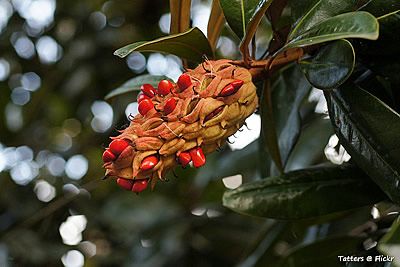The Southern Magnolia (Magnolia grandiflora) originates from the southeastern United States and is cultivated in various subtropical regions for its striking flowers and evergreen foliage. Of medium stature, it reaches an impressive height of 59 to 98 feet (18 to 30 meters), making it a superb choice for large-scale landscaping projects.
The trunk of Magnolia grandiflora is strong and straight, with a diameter ranging from 24 to 35 inches (60 to 90 centimeters). The branches of this tree spread harmoniously, forming a wide, pyramidal crown that not only provides shade but also adds architectural structure to the environment. Furthermore, the dense crown becomes a favored habitat for nesting birds and shelter for small mammals, enriching the local biodiversity.

Its leaves are equally impressive. Large, obovate, and simple, these leathery leaves have a glossy, dark green upper surface. In contrast, the underside is a rusty tone with a pubescent texture. These leaves, when they fall, form a dense carpet on the ground, which decomposes quite slowly. This aspect is crucial as it prevents the growth of ground cover and weeds, creating a natural, continuous mulching effect around the tree.
The flowering of the Southern Magnolia, occurring in spring, is a spectacle in itself. Its flowers are gigantic and white, reaching up to 12 inches (30 cm) in diameter. They are terminal flowers, exuding an intense citrus aroma, captivating not just the sense of smell but also sight. The subsequent fruit, an ovoid and dehiscent cone, contains numerous red to purplish seeds, adding even more visual interest to the plant.
It is interesting to note that Magnolia grandiflora has a remarkable diversity, with over 100 cultivars available. These vary in terms of crown shape, cold resistance, size, and even flower size, with some having flowers up to 14 inches (36 cm) in diameter. This diversity offers landscapers a wide range of options for different projects and environments.
In the landscaping of subtropical regions, the Southern Magnolia is an interesting choice, especially in places that require constant shade and protection throughout the seasons. The dark color of its canopy provides an excellent contrast with other garden species, creating a striking visual effect. The plant is versatile, suitable for use alone, in lines, or in groups, depending on the desired effect in the landscaping project.
Additionally, Magnolia grandiflora adapts well to wet or waterlogged soils, which is a benefit in areas with drainage problems. For optimal cultivation, full sun exposure is recommended. The soil should be fertile, deep, and enriched with organic matter, and regular irrigation is essential in the first years of establishment. Once established, it becomes a long-lived and resilient tree, even during periods of drought.
Another point to be highlighted is this tree’s ability to adapt to different environments, including coastal regions and urban centers with high air pollution. This is thanks to its resistant leaves, which are covered by a thick waxy layer, a remarkable adaptive trait.
Regarding cold resistance, the Southern Magnolia tolerates light frosts but is unsuitable for extremely cold climates, except for some cultivars selected for this purpose. As for its propagation, the tree multiplies by seeds, which have a germination rate of about 50%. For specific cultivars, propagation is vegetative, carried out by grafting onto rootstock produced from seeds, to preserve the characteristics of the cultivar.


